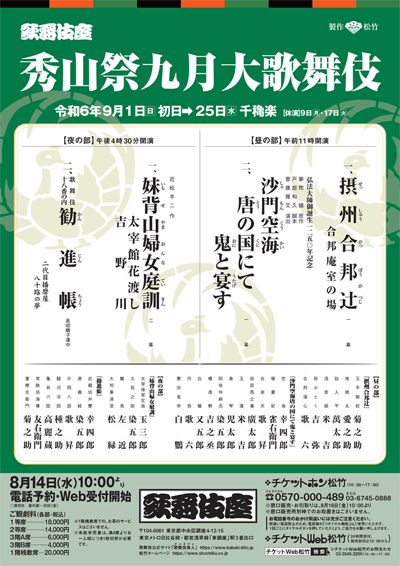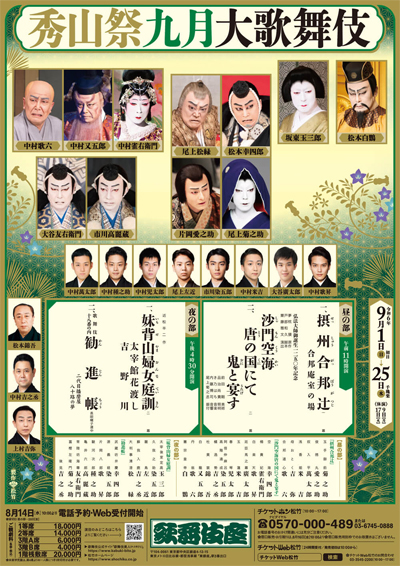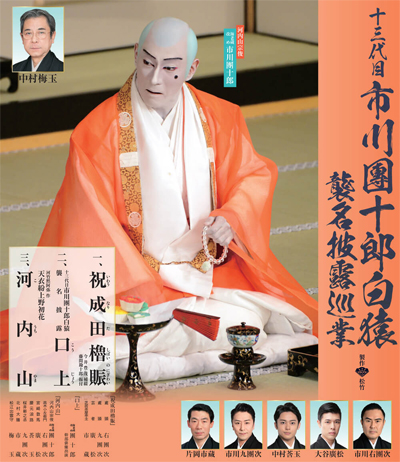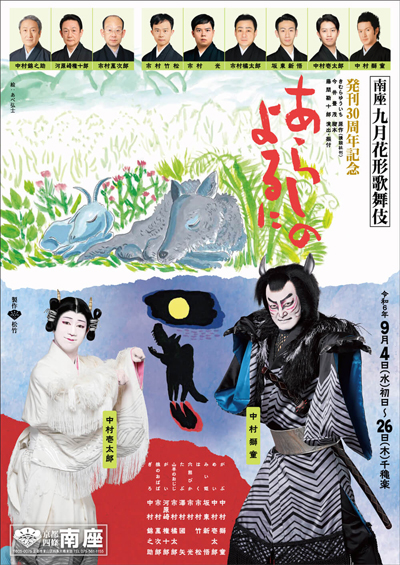| SEPTEMBER 2024 |
|
5 shows in T˘ky˘ (Kabukiza, New National Theatre, Asakusa K˘kaid˘, Asakusa K˘kaid˘), 1 in Ky˘to (Minamiza), 1 in ďsaka (National Bunraku Theatre) and 1 tour (Succession Announcement Tour)!
|
| Kabukiza (T˘ky˘) |  |
| Dates | 2 ~ 25 September 2024 Shűzan Matsuri Kugatsu ďkabuki Shűzan's Festival September Grand Kabuki |
| MatinÚe | |
| Evening |
|
| Casting |
Living National Treasure Band˘ Tamasabur˘, Living National Treasure Nakamura Karoku, Matsumoto Haku˘, Onoe Kikunosuke, Nakamura Jakuemon, Matsumoto K˘shir˘, Kataoka Ainosuke, Onoe Sh˘roku, Nakamura Matagor˘, ďtani Tomoemon, Ichikawa Komaz˘, Kamimura Kichiya, Nakamura Kotar˘, Nakamura Kash˘, Nakamura Yonekichi, ďtani Hirotar˘, Nakamura Mantar˘, Nakamura Tanenosuke, Ichikawa Somegor˘, Onoe Sakon, Nakamura Kichinoj˘ |
| Comments |
The 3rd edition at the Kabukiza of the new "Shűzan Matsuri" (the festival of Shűzan), which is staged to commemorate late Nakamura Kichiemon II. Shűzan was the haimy˘ used by both Nakamura Kichiemon I and Nakamura Kichiemon II. The newly-created Kabuki drama "Shamon Kűkai T˘ no Kuni nite Oni to Utagesu" is staged to celebrate the 250th anniversary of the birth of the Buddhist monk K˘b˘ Daishi (774~835).
|
 |
 |
| New National Theatre (T˘ky˘) |  |
| Dates | 1 ~ 25 September 2024 |
| Program |
Nyűmon Natsu Matsuri Naniwa Kagami o Tanoshimu
|
| Casting |
Kataoka Takatar˘, Band˘ Hikosabur˘, Ichikawa Omez˘, Kataoka Kamez˘, Band˘ Kamez˘, Sawamura S˘nosuke, Nakamura Matsue, Nakamura Takanosuke, Ichikawa Otora, Nakamura Tamatar˘, Nakamura Kamenoj˘, Kataoka Matsunosuke |
| Comments |
No performance at the National Theatre, which is no more operating in 2024 but there is a subsitute theater: the New National Theatre! This playhouse dedicated to opera, ballet or modern dances/dramas has become also a new home for Kabuki performances!
|
 |
 |
| Succession Announcement Tour | |
| Dates | 31 August ~ 27 September 2024 Jűsandaime Ichikawa Danjűr˘ Hakuen Shűmei Hir˘ Jungy˘ Ichikawa Danjűr˘ XIII Hakuen Succession Announcement Tour |
| Program |
Iwau Narita Shibai no Nigiwai |
| Casting |
Living National Treasure Nakamura Baigyoku, Ichikawa Danjűr˘, Ichikawa Udanji, Kataoka Ichiz˘, Ichikawa Kudanji, ďtani Hiromatsu, Nakamura Kangyoku |
| Comments |
A special tour celebrating the shűmei of Ichikawa Danjűr˘ XIII with performances in 18 cities.
|
 |
 |
|
|||
| Dates | 4 ~ 26 September 2024 Kugatsu Hanagata Kabuki September Young Actors Kabuki |
||
| Program |
Arashi no Yoru ni |
||
| Casting |
Nakamura Shid˘, Nakamura Kazutar˘, Nakamura Kinnosuke, Ichimura Manjir˘, Kawarasaki Gonjűr˘, Band˘ Shingo, Ichimura Takematsu, Ichimura Hikaru, Ichimura Kitsutar˘ |
||
| Comments |
A special program starring Nakamura Shid˘ and Nakamura Kazutar˘ and reviving the 2015 Kabuki drama based on Kimura Yűichi's famous series of illustrated child books "Arashi no Yoru ni" (in English 'One Stormy Night').
|
||
 |
 |
| National Bunraku Theatre (ďsaka) |
| Dates | 31 August ~ 1 September 2024 Ken no Kai |
| Program | |
| Casting |
Onoe Ukon, Nakamura Hashinosuke, Ichikawa En'ya, Nakamura Tsurumatsu, Ichikawa Seiko, Onoe Maholo, Onoe Kikusabur˘ |
| Comments |
8th edition of the Ken no Kai, a 2-day 4-performance gala in ďsaka at the National Bunraku Theatre starring Onoe Kikugor˘ VI's great-grandson Onoe Ukon. Ken no Kai literally means 'Ken's Association' with Ken being the first ideogram in Onoe Ukon's real first name Kensuke. The Ken no Kai is also held the 4th and the 5th of September in T˘ky˘ at the Asakusa K˘kaid˘ [more details]. |
|
|||
| Dates | 4 ~ 5 September 2024 Ken no Kai |
||
| Program | |||
| Casting |
Onoe Ukon, Nakamura Hashinosuke, Ichikawa En'ya, Nakamura Tsurumatsu, Ichikawa Seiko, Onoe Maholo, Onoe Kikusabur˘ |
||
| Comments |
8th edition of the Ken no Kai, a 2-day 4-performance gala in T˘ky˘ at the Asakusa K˘kaid˘ starring Onoe Kikugor˘ VI's great-grandson Onoe Ukon. Ken no Kai literally means 'Ken's Association' with Ken being the first ideogram in Onoe Ukon's real first name Kensuke. The Ken no Kai is also held from the 31st of August to the 1st of September in ďsaka at the National Bunraku Theatre [more details]. |
||
 |
| Dates | 12 ~ 13 September 2024 Kamiyach˘ Sh˘kabuki Kamiyach˘ Little Kabuki |
| Program |
Goaisatsu |
| Casting |
Nakamura Hashinosuke, Nakamura Fukunosuke, Nakamura Utanosuke, Nakamura Tsurumatsu |
| Comments |
2nd edition of a gala for Nakamura Shikan's three sons. It is entitled Kamiyach˘ Sh˘kabuki ('Kamiyach˘ Little Kabuki'). Kamiyach˘ was the name of late Nakamura Shikan VII's neighboorhood in T˘ky˘ and it was used as an original way to appraise this great actor (kakegoe). |
|
|
| Contact | Main | Top | Updates | Actors | Plays | Playwrights | Programs | Links | FAQ | Glossary | Chronology | Illustrations | Prints | Characters | Derivatives | Theaters | Coming soon | News |